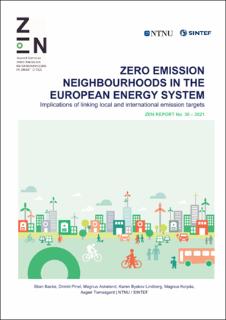| dc.description.abstract | Implications of linking local and international emission targets.
Political ambitions to mitigate climate change are driving the transformation of energy systems. These ambitions imply that greenhouse gas (GHG) emissions from the energy sector must reduce dramatically within the next decades. While electricity systems undergo a major transformation to reduce GHG emissions, other economic sectors that overlap with the electricity sector are also changing to reach the goals of a low carbon society. The building sector improves its energy performance standards, and pilot projects worldwide are continuously demonstrating buildings producing more renewable energy than their total energy demand over the building's lifetime. Within FME ZEN, the vision is to develop Zero Emission Neighbourhoods (ZEN): a collection of buildings that contribute to net-zero GHG emissions over their lifetime. In this study, we aim to link the development of ZEN with the decarbonization of the power system on the European level. The case study is set in the context of Europe and European climate policy targets, and we analyse the development of the power system for different future scenarios.
Results show limited ZEN development from the central power system perspective before 2050. After 2050, the combination of reduced technology costs for ZEN and a European system subject to strict emission regulation causes a significant development of ZEN across Europe, contributing to a decrease in total system costs by 4%. The feedback of the central power system is mainly less electricity production by nuclear and wind power plants. One important point is that surplus renewable energy produced within a neighbourhood does not reduce GHG emissions in the system directly. This is because the energy produced by the neighborhood does not replace energy produced with emissions but rather energy produced by other low carbon sources elsewhere in the system. However, we do observe that when ZENs are developed, the resulting emission allowance prices and total system costs are decreased. Hence, ZENs do not directly reduce emissions in the European power system, but has an indirect effect that reduces the cost of reaching the GHG emission targets. The role of emission compensation as a tool to reduce neighborhoods' net GHG emissions is a disputed assumption. Therefore, since we tackle this issue directly, the results from this study are important to quantify the overall benefit of ZEN in the European power system. Furthermore, the results can be applied in related fields of research, such as life cycle analyses of neighbourhoods. | |
